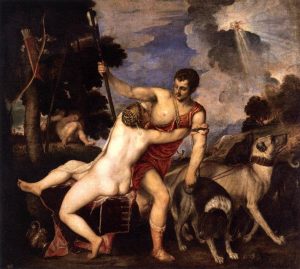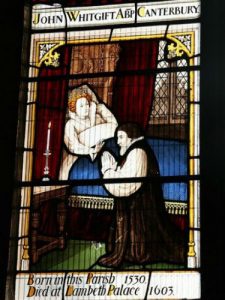The argument that Joseph Hall and John Marston were the earliest (sixteenth century) doubters of Shakespeare’s authorship was first developed by the Baconians: those non-Stratfordians who favour Sir Francis Bacon as the true author, or at least the chief co-ordinator, of the works we know as Shakespeare’s. H.N. Gibson, who argued against a range of authorship candidates in his book The Shakespeare Claimants (1964), concluded that B.G.Theobald, who developed this argument, was ‘probably correct in his identification of the poems concerned’ and called the argument ‘the one piece of evidence in the whole Baconian case that demands serious consideration.’
Marston and Hall appear to believe that Venus and Adonis and The Rape of Lucrece were written under a pseudonym. Nicknaming this author Labeo, Hall writes in the first satire of Book II of Virgidemiarum:
For shame write better, Labeo, or write none
Or better write, or Labeo write alone.
He seems to think that whatever Labeo has written, he has written it in conjunction with somebody else. He castigates Labeo as someone who ‘abjures his handsome drinking bowl’ because ‘the thirsty swain with his hollow hand’ has ‘conveyed the stream to wet his dry weasand [throat]’. Here he is referencing the Greek philosopher Diogenes, also known as the Cynic, who had rid himself of all his possessions except his drinking bowl, but cast this off too when he saw a peasant cupping his hands to drink. This is a perfectly workable metaphor on its own for someone who has cast elements of their life aside. But in the context of a possible reference to Venus and Adonis (which will shortly be established), it may refer to the prominent quote from Ovid which fronts that work, relating to the Castalian spring, close to the Oracle at Delphi, where Roman poets went to receive inspiration. Then switching to italics for emphasis, Hall says:
Write they that can, tho they that cannot do:
But who knows that, but they that do not know?
At first sight, ‘they that cannot [write] do’ brings to mind Robert Greene’s ‘he that cannot write true English’ needing to make himself ‘the father of’ plays. In this case, the second line of the couplet is translated as the secretive (and deniable) nature of the ‘underhand brokery’. But another interpretation is that bad writers write even though they cannot write (well), and being bad writers, don’t have sufficient judgement to know they can’t write. Hall’s general criticism of Labeo’s poetry suggests this second interpretation is quite likely.
Yet there is a genuine accusation that Labeo is not writing under his own name, but someone else’s. In the first satire of Book IV, Hall says:
Labeo is whipped, and laughs me in the face:
Why? for I smite and hide the gallèd place.
Gird but the Cynic’s Helmet on his head,
Cares he for Talus, or his flail of lead?
Long as the craftie Cuttle lieth sure
In the black Cloud of his thick vomiture;
Who list complain of wronged faith or fame
When he may shift it on to another’s name.
‘Hide’ in the second line doesn’t mean conceal, but ‘thrash’ – another verb to go with ‘whipped’ and ‘smite’. The reference to the ‘Cynic’s Helmet’ is another reference to Diogenes the Cynic. It was reported that ‘when asked what he would take to let a man give him a blow on the head, he said “A helmet”’; Labeo is protected from being whipped, and just how he is protected, Hall is about to make plain. ‘Talus, or his flail of lead’ is a reference to the iron man in Edmund Spenser’s The Faerie Queene (1590/1596), who, with a metal flail, ‘threshed out falsehood, and did truth unfold’.[1] And what follows is Hall’s unfolding of truth.
The cuttlefish is known for defending itself from its enemies by squirting a cloud of black ink. Labeo, says Hall, ‘lies sure’ in a defensive cloud of black ink. ‘List’ is used in the archaic sense of ‘likes to, desires to or chooses to’ and Hall says that Labeo, concerned with the issues of ‘wronged faith or fame’ is protecting himself by ‘shift[ing] it on to another’s name.’ Whether or not Labeo is the author Shakespeare, this is undoubtedly another piece of fairly explicit 16th century evidence supporting the idea that using another person’s name was a known practice in this dangerous era (an era when ‘fame’, especially if linked to issues of religious faith, could be deadly). Though Venus and Lucrece are not identified by name, references to the stylistic elements of both Shakespeare poems in other passages addressed to Labeo make them strong candidates as Hall’s target.
What are these elements? Read on.
[1] Edmund Spenser, The Fairie Queene, IV, i, 37-44.
Click Here to Subscribe and we’ll notify you about new content.


